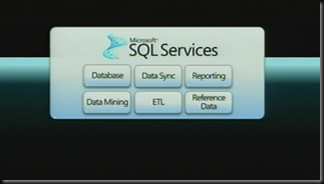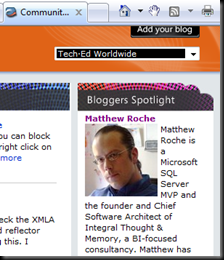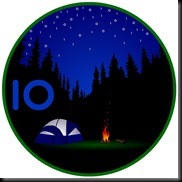I own lots of laptops. After being an independent software development and BI consultant for many years, I've assembled quite the collection. I have Dells and Toshibas[1] and have had Gateways and HPs as well. My little home office is filled with them[2].
I also have a Lenovo. It's a ThinkPad X300, and if I never needed to type on it, it would probably be one of my favorite computers. It's light, it's powerful, it's solid, and just about everything you could want a laptop to be.
But I do have to type on it. And because of this, I swear. A lot. In fact, I swear so much I just may need a new chart.
Why all the swearing, you ask? Well, before I answer, please take a look at your keyboard, down in the bottom left corner. Go on. I'll wait.
There.
You see, if you're typing on a ThinkPad, you'll probably[3] notice that the bottom left key is the control "Ctrl" key, and to the right of that (if you're using a laptop anyway) is the function "Fn" key.
Still with me? Good.
Now if you were horribly evil in a past life and are currently being punished by having to type on a ThinkPad, you'll instead notice that the Fn and Ctrl keys have been reversed. Swapped. Inverted.
And this is insane!
Ok, you ask - what's the big deal? Who cares?
First and foremost - me. I care a lot. You see, I'm a developer. And while I don't buy in with the whole developer stereotype[4] I definitely am a very keyboard-centric computer user. I prefer to use my keyboard whenever possible, and there are literally thousands of times each day when I perform some task that utilizes a Ctrl+Key keyboard shortcut. For example, you may be familiar with some of these well-loved productivity enhancers:
- Ctrl-C = Copy
- Ctrl-V = Paste
- Ctrl-Arrow (Left or right) = Jump one word in text
- Ctrl-Shift-Arrow (Left or right) = Jump and highlight one word in text
- Ctrl-F4 = Close current tab or child window
I could go on and on and on. A significant portion of the most common Windows keyboard shortcuts involve the Ctrl key.
Now at this point you're probably asking "But Matthew, since this incarnation of ultimate evil that Lenovo uses for a keyboard inverts the Ctrl and Fn keys, what do these keyboard shortcuts do if your finger, trained through decades of computer use, hits the Fn key instead?"
Funny you should ask. This is what happens:
- Fn-C = Nothing
- Fn-V = Nada
- Fn-Arrow (Left or right) = Zip
- Fn-Shift-Arrow (Left or right) = Zilch
- Fn-F4 = Puts the computer to sleep!!!!!
That's right. If you try to close out a child window and let your fingers follow the paths that are ingrained deep in their muscle memory, you have just effectively closed the lid on your accursed laptop and have shut it down. Even if you're in the middle of working. Even if you're in the middle of a giant download that then needs to be restarted. Even if you're connected remotely to the corporate network and you then need to dig out your smart card so you can re-connect. Even if you're hosting a LiveMeeting that your boss' boss' boss is attending. Yeah. Even then.
I could go on. I could rant about how there is no way to re-map these keys, because the Fn key isn't exposed to the standard Windows keyboard APIs. I could rave about how the Esc key is on its own row above the function keys (F1 through F12) so that when I try to hit F2 to rename a file I get F3 (search) and when I attempt to hit Esc I get F1 (help) instead. I could blow my top and go on and on about how when I use my other laptops (which outnumber my lone ThinkPad 7:1 at this point) the lessons that my poor fingers are being forced to learn are tripping me up when I use normal keyboards. I could go on and on and on...
But I won't. Because it's far too late for a rant like this to go on any further. Instead, I'm going to fill out a little survey that Lenovo has put together. And I encourage you to do the same. Please, please, please do the same.
I think it's great that Lenovo is conducting such a survey. But I think it is very frustrating that they're just getting around to asking. Take a few minutes and Live Search around on "ThinkPad" and "keyboard" and you'll see what I mean - dozens of other frustrated ThinkPad owners have poured their anguish into the ether as well. (My favorite one is here.) And even more frustrating, the survey doesn't even mention the Fn and Ctrl key positions - it focuses on the Esc, Home, End, PgUp and PgDn keys instead. Ugh...
But hopefully they're listening now. This is what I told them at the end of my survey, in response to the question "Of the keys that vary between different key layouts, for which keys are you most concerned about their location (e.g. Esc, Home, End, PgUp, PgDn, others, etc.)?":
"The Ctrl key MUST be in the bottom-left corner, immediately below the Shift key. If this is not the case in the hardware then there MUST be a way to re-map these keys in the OS or BIOS. Yes, you need to keep your historic users happy, but you also need to understand the basic mechanics of using keyboard shortcuts and the PAIN that users feel when attempting to adjust to the ThinkPad's non-standard layout. Until one of these solutions is implemented I will never buy or use another ThinkPad."
And I won't. It pains me that much. There are lots of small, light, powerful laptops out there just waiting for my hardware budget, and only the ThinkPad comes with a keyboard that makes my typing life miserable every day. It's a show-stopper for me, and I will never buy another laptop without looking at the keyboard first.
But now it's time for me to sleep. And hopefully to dream of non-ThinkPad keyboards...
[1] Which is another story, but probably not one I'll rant about just yet...
[2] And, in the winter, heated by them.
[3] I saw "probably" simply because I have not owned one of every type of computer ever made, but for my own personal sample "probably" means 100% of the time.
[4] For example, I dislike Red Bull, don't drink Mountain Dew, and I'm tall, good looking[5] and very comfortable around members of the opposite sex. ;-)
[5] Humble, too.



 Since the beginning of the year I've had the Microsoft Most Valuable Professional (MVP) logo on my blog. I've been delighted to be honored with the MVP award, because is is an acknowledgment of the effort I've made to give back to the Microsoft technical community. This is what Microsoft has to say about the MVP award:
Since the beginning of the year I've had the Microsoft Most Valuable Professional (MVP) logo on my blog. I've been delighted to be honored with the MVP award, because is is an acknowledgment of the effort I've made to give back to the Microsoft technical community. This is what Microsoft has to say about the MVP award: